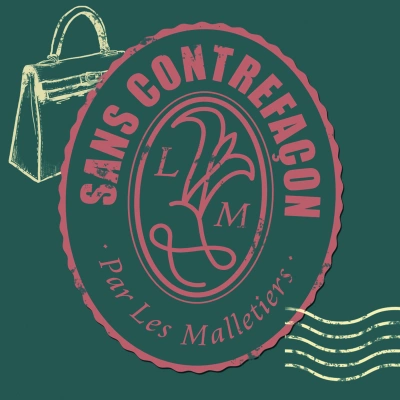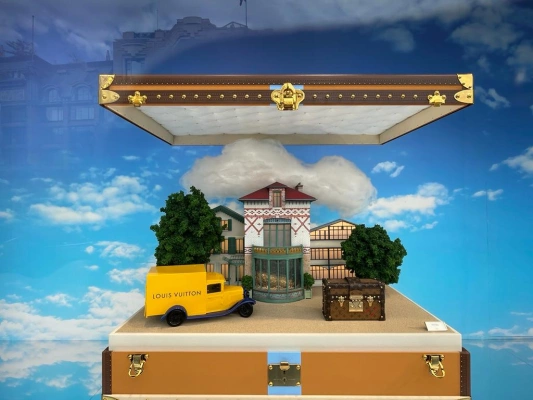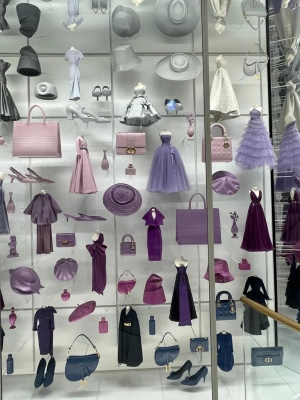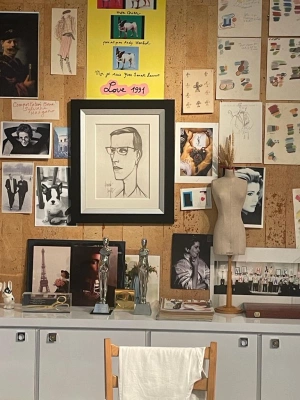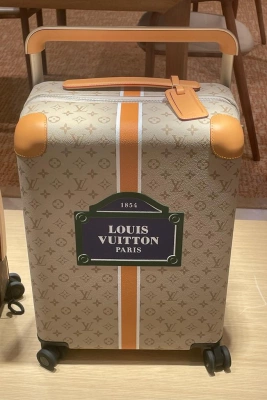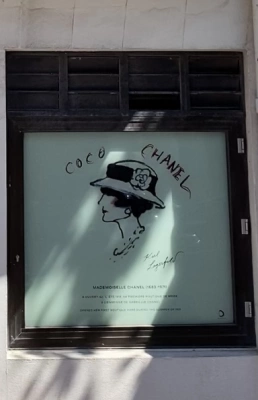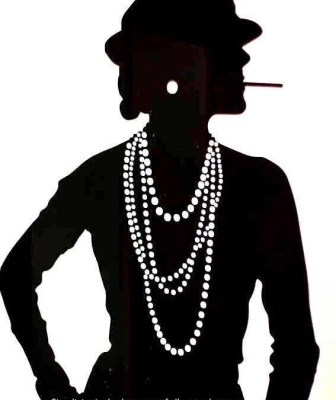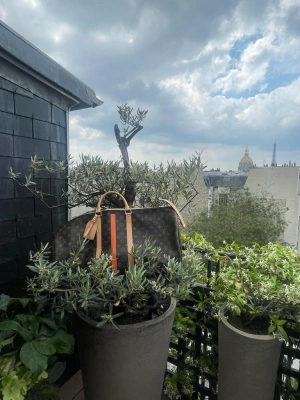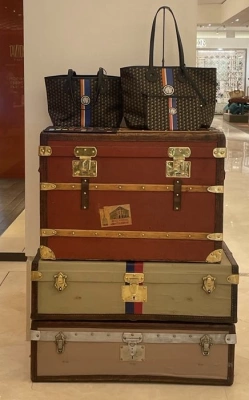Are you sure you want to perform this action?
Newsletter
Inauguration du Show Room Les Malletiers
Listen to our Podcast about Style. The worlds blend together...without counterfeiting!
Several times a month, our team interviews personalities who tell us about their passion, their passion, their career...
And always with a nod to La Maroquinerie.
Visit the LV Dream exhibition at 26, quai de la Mégisserie in the 1st arrondissement.
It's definitely worth the diversions!
The LV Dream exhibition is located right in the heart of Paris, along the quays, in a historic building just in front of the Samaritaine.
This exhibition invites visitors to take an immersive journey, discovering the various historical and contemporary artistic collaborations of this unrivalled house.
It's a journey through iconic trunks and bespoke pieces that illustrate the mastery of many different skills.
A true visual experience!
What a privileged opportunity to visit 11, rue François 1er to discover this magical place behind closed doors!
Here, everything is luxury, calm and pleasure!
The setting is magical!
The Galerie Dior, with its scenographic narrative, symbolises the spirit of Parisian haute couture as much as it perpetuates the memory of this historic address.
As Christian Dior said in 1956, "Couturiers embody one of the last refuges of the marvellous. They are, in a way, masters of dreaming. #
He also recommended to his readers in Le Petit Dictionnaire de la Mode: # Like all your clothes, your bag deserves your attention #
Do you know the 5 most emblematic Dior bags? Take notes!
The Lady Dior salutes the royal icon of fashion, Lady Diana, Princess of Wales.
The Saddle Dior in the shape of a horse's saddle, designed by fashion genius John Galliano
The Dior Book Tote, designed by Maria Grazia Chiuri
The Diorama designed by Raf Simons
The Dior 30 Montaigne, one of the most recent, released in 2019, a wardrobe staple.
At Les Malletiers, we like to perpetuate the taste for beautiful things!
Have you ever had the chance to visit the Pierre Bergé - Yves Saint Laurent Foundation in Paris at 5, avenue Marceau in the 16th arrondissement?
It's a magical place! A Second Empire-style mansion where Yves Saint Laurent set up his workshops in 1974, and where he asserted his style for 28 years until 2002, the year he ended his career.
The exhibition of the moment: Formes.
The exhibition features some forty haute-couture and ready-to-wear models, accessories and sketches, all of which resonate with the sets and works of German artist Claudia Wieser. It's an original experience that places the designer's genius firmly in the contemporary context.
As Yves Saint Laurent said in 1977: "I'm classic when I love Molière. I'm also classic when I work in refined settings. But underneath the classical exterior, I have very modern tastes. My favourite painters are Mondrian, Picasso, Fernand Léger... That said, whether our sensibility leads us towards traditional classical art or towards avant-garde forms, we have to maintain links with the past.
Yves Saint Laurent is both elegance and timelessness.
Two words that we appreciate enormously at Les Malletiers!
Asnières, the beating heart of Louis Vuitton
Have the privilege to visit this magical place on a private tour and the magic happens immediately. You might even say you fall under its spell.
This emblematic site in the Paris region combines the Art Nouveau-style family home of the founder Louis Vuitton, the traditional trunk-making workshops and a completely renovated gallery space.
The Asnières site remains the heart and soul of Louis Vuitton even 170 years after its birth.
The family house, built in 1860 next to the typical Eiffel-era workshops, is like a journey back in time, where nothing has changed for more than a century and a half.
Photos of all 5 generations are displayed on the pedestal table in the winter garden lounge. They show Louis, the founder, and his wife Clémence - Emilie Parriaux, their son Georges, who took over in 1892, Gaston, the grandson, and Patrick-Louis Vuitton, who ran the Asnières workshop and special orders until his death in 2019.
Vuitton is a true family saga.
Who would ever have believed that Louis Vuitton, a native of the Jura from a very simple background who moved to Paris in the late 1830s, would create a brand that is still so famous and recognised 170 years after its creation.
His credo: at the time of the first journeys and the steam engine, he had the idea of creating stackable trunks, covered in canvas to be more functional and resistant.
That's what we call being visionary, but it's also about being bold. That's the key to success.
As for the workshops, they're a closely guarded secret!
In 1910, Coco Chanel opened a hat boutique (Chanel Modes) at 21, rue Cambon, in Paris, with the help of her protector and friend Etienne Balsan and Arthur Capel (known as Boy), who had become her lover.
A new Gabrielle Chanel boutique opened in Deauville in 1913, first selling hats, then quickly clothing.
In 1914, with the outbreak of the First World War, Coco Chanel remained in the seaside resort of Deauville, which was very popular with wealthy Parisians.
That same year, Gabrielle Chanel spent a weekend in Biarritz, a place where business was done in wartime, with her lover Boy. A third boutique opened the following year in this city spared by the war.
When the war ended in 1918, Gabrielle Chanel repaid her lover's investment and became financially independent.
She opened another boutique at 31, rue Cambon in Paris.
In the 1920s, the world economy recovered from the war and Coco Chanel expanded her activities by opening workshops, offices and another boutique at number 31 and later offices at numbers 25, 27 and 23 rue Cambon. A sales outlet also opened in Cannes.
Chanel thus began her empire...
Coco Untold Stories, the early years...
She symbolizes French elegance. Gabrielle Chanel, born in Saumur in 1883, whose real name was Gabrielle Chasnel, was raised in an orphanage. At the age of 12, she was taken in with two of her sisters at Aubazine Abbey in Corrèze.
Her mother died in Brive-la-Gaillarde in 1895. When she was just 12, her father abandoned her a few months later, to the care of the nuns. He never returned. Gabrielle went to Aubazine to learn sewing. She stayed for 6 years. The abbey would remain a powerful source of inspiration for the codes of the House of Chanel...
Coco Chanel's taste for clean lines and her predilection for black, white and beige are perhaps linked to the sobriety of the abbey and its occupants...
Once she left Aubazine, she moved to Moulin. Gabrielle had to earn a living, so she sang in small shows in bars, famous for her rendition of
“Who has seen Coco on the Trocadero? Coco, a nickname that has stuck for posterity...
Louis Vuitton's Keepall travel bag, the 1930s... Cruises were fashionable, as were holidays in Deauville and Biarritz.
At that time, Louis Vuitton, renowned for its trunks, had to adapt to these new lifestyles. The result was the Keepall, a bag that "keeps everything". The Keepall is a flexible, zipped bag made from the famous monogrammed coated canvas. Its generous shape allows you to slip in a sports outfit and a few simple clothes for a weekend in the countryside.
An immediate success, the Keepall has never left the Louis Vuitton catalogue. It has been used in the trunk-maker's other collections, and given a new look by artists invited by Marc Jacobs, including Takashi Murakami and others.
Four sizes were chosen (45, 50, 55 and 60 cm), with the first three being the most popular because they could be carried in the cabin.
Seen over and over again on all the people for generations, the Keepall is now a timeless piece, which we keep, cherish and watch lovingly polish... Les Malletiers loves it too!
The history of luggage dates back to ancient times, when people used cloth bags or woven baskets to carry their belongings. However, these bags were often bulky and impractical to carry over long distances.
Over the centuries, luggage evolved to become more functional and adapted to travellers' needs. In the Middle Ages, nobles used wooden chests to carry their belongings when travelling. These chests were often heavy and required several people to carry them.
With the advent of rail and sea travel in the 19th century, luggage underwent a new evolution. Wooden trunks became popular, offering better protection for fragile objects. These trunks were often adorned with leather or canvas and were used by wealthy travellers.
In the 20th century, the arrival of commercial aviation led to a further transformation of luggage. Rigid metal or plastic suitcases became common, offering greater shock resistance and storage capacity. Wheels were also added to make transport easier.
Today, luggage is available in a wide variety of shapes, sizes and materials. Many models are available from Les Malletiers....





